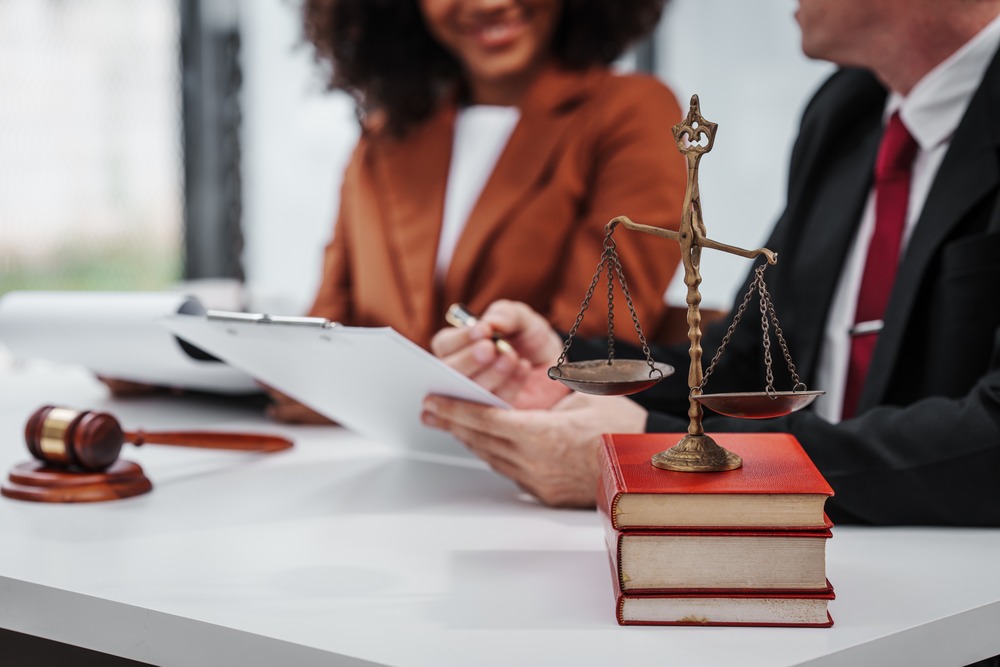Ever been injured because of someone else’s carelessness? Maybe a spilled drink at a restaurant sent you tumbling, or a reckless driver caused a collision. Suddenly you face medical bills, lost work, and long-term pain.
This is where a personal injury lawsuit comes in. It can provide a legal path for you, the injured party (known as the plaintiff), to seek financial compensation from the person responsible (the defendant) for your losses.
In simpler terms, it’s a way to hold someone accountable for your injuries and get back on your feet financially. Personal injury lawsuits happen in civil court, separate from criminal proceedings.
The aim isn’t jail time for the defendant but to recover damages for your expenses, including:
- Medical bills
- Lost wages
- Pain and suffering
- Emotional distress
If you or your loved one has been injured due to someone else’s negligence, reach out to an experienced personal injury lawyer today.
10 Steps in a Personal Injury Lawsuit: What You Need to Know
Understanding personal injury lawsuits is a good start. But what are the steps in a personal injury lawsuit? From getting things rolling to reaching a resolution, let’s talk about it.
Step 1: Seek Medical Treatment

First and foremost, if someone hurts you, you need to get medical attention ASAP. Even if your injuries initially seem minor, have a doctor check you out. Some injuries may not show severe symptoms immediately but can worsen over time if left untreated.
Plus, promptly seeking medical care shows that you took your injuries seriously and helps create a clear record linking your injuries to the incident.
Step 2: Choose an Experienced Personal Injury Attorney
Next, you’ll want to find a knowledgeable personal injury lawyer to protect your rights and fight for the best possible outcome in your case. Look for an attorney who has extensive experience handling cases similar to yours and a proven track record of success.
Many personal injury law firms offer free initial consultations, where you can sit down with a lawyer, review your case, and get advice on your legal options. During the consultation, the attorney will ask about the incident, your injuries, and any damages you’ve incurred.
They’ll also evaluate the strength of your case and recommend the best path forward. If you decide to hire them, you’ll usually enter a contingency fee agreement. This means you won’t have to pay any upfront legal costs, and the attorney will only collect legal fees if they win a settlement for you.
Step 3: Your Attorney Investigates Your Case
Once you’ve got legal representation, your personal injury attorney will start digging into the details of your case. They’ll gather evidence from various sources to build a strong foundation for your claim.
This may include:
- Police reports and incident reports
- Medical records and bills related to your injuries
- Documentation of any lost wages or income due to your injuries
- Witness statements from anyone who saw the incident or its aftermath
- Photos and videos of the scene, your injuries, and any property damage
- Physical evidence, such as damaged clothing or equipment
Your personal injury attorney will also identify all potential sources of liability and insurance coverage. In some cases, multiple parties may share responsibility for your injuries, and several insurance policies may apply to your claim.
Investigating your case early on allows your attorney to build the strongest possible argument on your behalf and avoid missing any critical deadlines or opportunities to gather evidence.
Step 4: A Demand Letter is Sent
Many personal injury cases kick off with your attorney sending a demand letter to the at-fault party’s insurance company. This letter outlines your case, describes the severity of your injuries, and lists the damages you suffered. It also specifies a settlement amount you’d accept to resolve the case out of court.
The insurance company will review the demand letter and decide whether to accept it, deny it, or make a counteroffer. This often triggers settlement negotiations between your lawyer and the insurance company.
If the insurance company agrees to your demand or offers a fair settlement, you can wrap up your case without going to court. However, if they deny your claim or lowball you with an unreasonable settlement offer, your attorney may recommend filing a personal injury lawsuit to protect your rights and seek the compensation you deserve.
Step 5: Your Attorney Files a Personal Injury Lawsuit
Filing a personal injury lawsuit involves your attorney drafting and filing a formal complaint with the appropriate court.
The complaint will include:
- The legal basis for holding the defendant liable for your injuries
- A description of how the incident occurred and how the defendant’s negligence caused your injuries
- A detailed account of your injuries and the medical treatment you’ve received
- An itemized list of your damages, including medical expenses, lost income, pain and suffering, and any other losses related to the incident
Once the complaint is filed, the court will issue a summons, a document that notifies the defendant of the lawsuit and requires them to respond within a specific timeframe.
Step 6: The Defendant Answers the Complaint
After being served with the complaint and summons, the defendant has a limited time to file a response with the court. In their answer, the defendant will admit or deny the allegations outlined in the complaint.
They may also assert various defenses, such as claiming that you were partially or wholly at fault for the incident or that your injuries were pre-existing and not caused by their actions.
Step 7: The Discovery Process Begins
Discovery is the formal exchange of evidence and information between you and the defendant. The purpose of discovery is for both sides to learn more about the other party’s claims, defenses, and evidence.
This process prevents surprises at trial and allows each side to build a stronger case.
Discovery may include:
- Written discovery: Interrogatories (written questions), requests for documents, and requests for admission
- Depositions: Out-of-court testimony given under oath by parties, witnesses, and experts
- Independent medical examinations: Medical exams conducted by a doctor chosen by the defense to assess the extent and cause of your injuries
- Expert witness evaluations: Assessments of the evidence and depositions given by expert witnesses, such as medical professionals, accident reconstruction specialists, or economists
The discovery process can be lengthy, often lasting several months or even years in complex cases. During this time, your personal injury attorney will work diligently to gather the evidence to support your claim and build a compelling case.
Step 8: Pretrial Motions are Filed
Before the trial begins, either side may file motions with the court to resolve legal issues or request specific actions.
Common pretrial motions in personal injury cases include:
- Motion for summary judgment: Asks the court to decide the case based on the undisputed facts without going to trial
- Motion to dismiss: Seeks to have the case dismissed based on insufficient legal claims or lack of evidence
- Motion to compel: Requests a court order for the other side to comply with discovery requests or provide specific information
The outcome of these motions can significantly impact the course of your case. Sometimes, a successful motion may lead to a dismissal of the case or a favorable settlement for you.
Step 9: Mediation Takes Place
Many courts require parties to attempt mediation or another form of alternative dispute resolution before proceeding to trial. During mediation, a neutral third party (often a retired judge or experienced attorney) facilitates negotiations between you and the defendant to reach a mutually agreeable settlement.
Mediation offers many advantages:
- It allows both sides to have more control over the outcome of the case
- It can lead to a faster resolution and eliminate the need for a lengthy and expensive trial
- It provides a more private and less formal setting to discuss the case and explore settlement options
If mediation succeeds, the case will resolve through a settlement agreement. If not, the case may proceed to trial.
Step 10: Your Case Goes to Trial

A judge or a jury may decide a personal injury trial, depending on the specifics of your case and the jurisdiction where you try it.
Jury Trial
In a jury trial, the process begins with jury selection, where potential jurors are questioned to determine their suitability to serve on the case.
Once the court selects the jury, both sides present opening statements outlining their key arguments and evidence.
- Your attorney will then present your case-in-chief, calling witnesses, introducing evidence, and making arguments to support your claim. The defendant’s attorney will then cross-examine your witnesses and challenge your evidence.
- Once your case is presented, the defendant will have the opportunity to present their evidence and witnesses, which your personal injury attorney will then cross-examine and refute.
- After both sides rest their cases, they will deliver closing arguments. The judge will then instruct the jury on the applicable laws and deliberation process.
- The jury will then retire to consider the evidence and reach a verdict. If the jury reaches a decision, the court will deliver the verdict. If the jury cannot decide, the court may declare a hung jury, and the parties may retry the case.
Bench Trial
In a bench trial, the process is similar, but the judge takes on the jury’s role.
After hearing opening statements, the judge will listen to the evidence and arguments presented by both sides.
- Your attorney will present your case-in-chief, and the defendant’s attorney will have the opportunity to cross-examine your witnesses and challenge your evidence. The defendant will then present their case, which your attorney can cross-examine and refute.
- Following the presentation of evidence, both sides will deliver closing arguments. The judge will then review the evidence, apply the relevant laws, and reach a decision. The judge may issue their ruling immediately after closing arguments or take some time to deliberate before announcing the verdict.
Throughout the trial process, whether a bench trial or jury trial, your attorney will keep you informed of developments and work diligently to present the strongest possible case on your behalf. Having a powerhouse legal team by your side can make all the difference in securing a favorable outcome.
Step 11: The Verdict is Delivered
The judge or jury will award damages if the verdict favors you.
You may recover two types of damages in personal injury cases:
- Compensatory damages: Meant to compensate you for economic losses (e.g., medical expenses, lost wages) and non-economic losses (e.g., pain and suffering, emotional distress)
- Punitive damages: Awarded in rare cases involving particularly egregious conduct to punish the defendant and deter similar behavior
If the defendant prevails, the court will dismiss the case. After a dismissal, you can file an appeal, which asks a higher court to review the case for legal errors or improper rulings.
Step 12: Collecting Your Judgment
After a successful verdict, the final step is collecting your judgment from the defendant. If the defendant has applicable insurance coverage, your attorney will coordinate with the insurance company to collect the payment.
Your lawyer can help you explore other avenues for collection from an uninsured or underinsured defendant, such as wage garnishment or property liens.
Sometimes, the defendant may file post-trial motions or an appeal, which can delay the collection process. Your attorney will guide you through any post-trial proceedings and work diligently to ensure you receive the compensation you were awarded.
What Are the Steps in a Personal Injury Lawsuit: Final Thoughts
The steps in a personal injury lawsuit can take time, from the initial consultation with an attorney to the final resolution of your case. However, understanding these steps and having a powerhouse legal team by your side can make the process much more manageable.
At Wilshire Law Firm, we have extensive experience guiding accident victims through every stage of their personal injury lawsuit. Our attorneys have the knowledge, resources, and determination to build strong cases and fight for the justice and compensation our clients need.
With over $1 billion recovered in settlements and verdicts, we have a proven track record of successfully handling even the most complex cases.
Get Justice, Get Paid with Wilshire Law Firm
If someone else’s negligence injures you or a loved one, don’t hesitate to contact us. Let us use our experience to seek the justice and financial recovery you need to move forward with your life.











